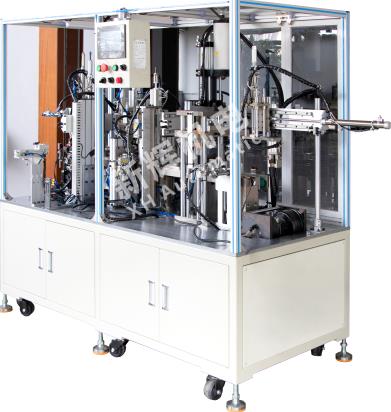What are the common software problems and solutions for DC motor motor automatic carbon brush cover assembly machine?
1, program crash or crash
Problem performance:
The software suddenly stops working during operation, the interface is unresponsive, and the whole operation process of the assembling machine is interrupted. This may be due to errors within the software, memory leaks or hardware resource conflicts.
After running for a long time, the software appears to be stuck, unable to perform any operation, affecting productivity.
Solution:
Reboot the software and device: try to close the software and reopen it, if the problem still exists, reboot the whole assembler to clear out possible temporary faults and memory hogs.
Check for software updates: check to see if the software developer has released an updated version, updates may contain bug fixes and performance optimizations. Install the new version to address known software bugs and stability issues.
Analyze system resource usage: Use system monitoring tools to check the usage of resources such as CPU, memory and disk I/O. If you find that a certain resource is over-utilized, it may be that a module in the software has an infinite loop or is over-utilizing resources. At this point, you need to contact the software provider or professional maintenance personnel to further analyze the software code to find and repair the part of the abnormal resource usage.

2、Software compatibility problems
Problem performance:
After updating the operating system, replacing the hardware or installing other related software, the control software of the carbon brush cover assembly machine appears incompatible. For example, the software interface display abnormality, some functions can not be used normally or communication problems with external devices (such as sensors, controllers).
The software shows different compatibility problems in different computer environments (such as different versions of Windows operating system), which affects the generality and portability of the software.
Solution:
Check the software system requirements: Confirm the requirements for the operating system, hardware configuration, and other software dependencies listed in the software's official documentation. Ensure that the operating environment of the assembler meets these requirements, and if not, consider upgrading or adjusting the hardware and operating system.
Update drivers: Drivers for hardware devices (e.g., PLCs, sensors, etc.) may not be compatible with the software. Visit the hardware manufacturer's website to download and install new drivers to ensure good communication between the software and hardware.
Use compatibility mode or a virtual machine: If the software has compatibility issues with a new operating system, try running the software in an older version of compatibility mode. Or, use virtual machine software to create an operating system environment compatible with the software to run the software.
3. Wrong or missing parameter settings
Problem performance:
Key parameters in the software (such as assembly speed, pressure control parameters, sensor thresholds, etc.) are set incorrectly, resulting in poor working results of the assembler, such as carbon brushes or cover assembly is not strong, inaccurate position, etc.
Parameters are lost after software restart or system failure and need to be reset, increasing the complexity and time cost of operation.
Solution:
Backup and Restore Parameters: Backup the parameter settings of the software regularly and store the backup file in a reliable location. When parameters are lost or incorrect, they can be restored using the backup file. At the same time, check whether the software has an automatic backup function and make sure it works properly.
Parameter verification and adjustment: Add a parameter verification mechanism to check whether the parameters are within a reasonable range when the software is started or after the parameters are modified. If parameter errors are found, prompt users to make correct settings. For key parameters, default values can be set to ensure that the software can run in basic working mode when parameters are lost.
Enhance user rights management: Set appropriate user rights for the parameter setting function to prevent unauthorized users from modifying the parameters by mistake. Through user authentication and permission assignment, ensure that only trained personnel can modify key parameters.
4、Software communication failure
Problem performance:
Communication between the software and the underlying hardware (e.g., motor controller, sensor interface) is interrupted, resulting in the inability to obtain real-time data or send control commands. This may be manifested in the software can not receive the position signal of the sensor, can not control the speed of the motor and so on.
Communication problems between the software and the upper computer (e.g., production management system) or other networked devices, affecting the uploading and downloading of data, such as the inability to send production data to the management system or receive updated production tasks.
Solution:
Check the communication lines and interfaces: first check whether the communication cables between the software and hardware are firmly connected and whether the interfaces are loose or damaged. For wired communication, use a tester to check the on-off condition of the line; for wireless communication, check whether the signal strength and frequency band settings are correct.
Communication protocol check and configuration: Confirm whether the communication protocol used by the software and hardware is consistent, including baud rate, data bits, stop bits, parity bits and other parameters. If the protocol configuration is wrong, reconfigure the communication protocol parameters to ensure that both sides can communicate correctly.
Software communication module debugging: If there is no problem with the communication lines and protocols, the communication module within the software may be faulty. Use debugging tools (such as serial port debugging assistant, network debugging tools, etc.) to check whether the data sent and received by the software is correct. Check the code of the communication module to fix possible errors, such as data format errors, buffer overflow, etc.
※: If you still can't solve the equipment failure by the above ways and means, please contact the technical specialist of Xinhui Electromechanical Equipment Co., Ltd. through the page chat tool to seek help.







